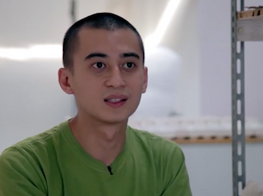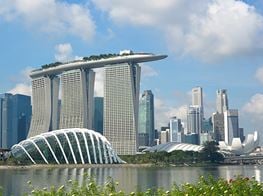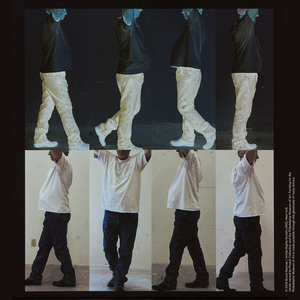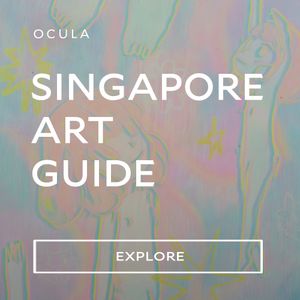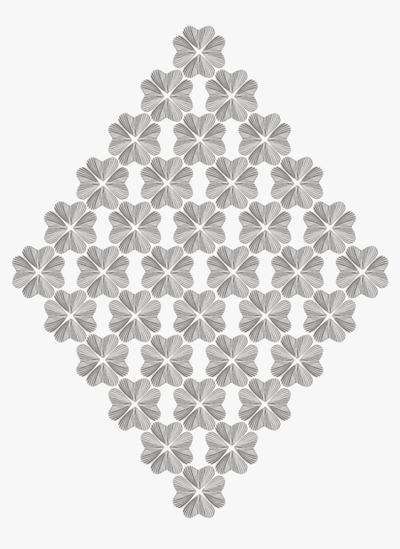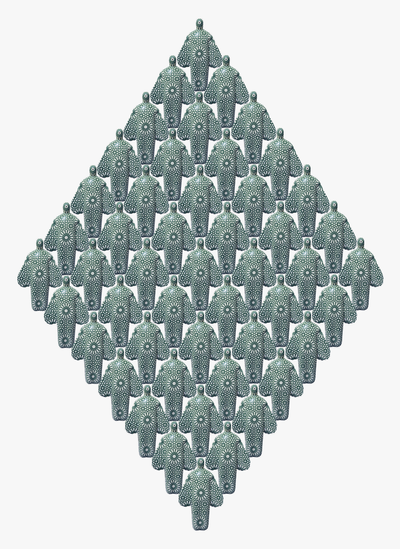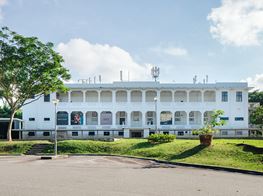Albert Yonathan Setyawan: Some Kind of Devotion
IN PARTNERSHIP WITH GILLMAN BARRACKS
Albert Yonathan Setyawan believes there's a holiness in recurrence. Born in Bandung, the Indonesian artist is known for his drawings and performances, but is perhaps most widely recognised for his masterfully made and diminutive ceramic sculptures, replicated by the hundreds and arranged in geometric or mandala-like formations.
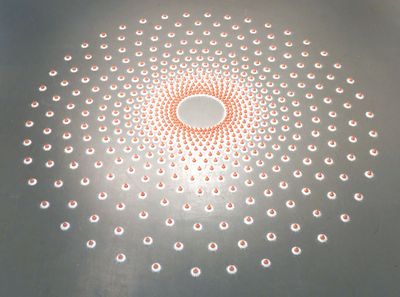
Albert Yonathan Setyawan, Mandala Study #4 (2015). Terracotta and marble sand. Dimensions variable. © Albert Yonathan Setyawan. Courtesy Mizuma Gallery, Singapore/Tokyo.
Ritual is integral to his practice, which aims to eclipse the limitations of sculpture by achieving transcendence through the medium. By repeating motifs such as birds, plants, moths and religious symbols in his works, Setyawan aims to draw connections between natural and spiritual worlds.
Absorbing the histories of Buddhist and Hindu iconographies and often borrowing their forms, Setyawan locates spirituality outside the boundaries of institutional religion—a particularly personal subject for him. His sculptural installations have been compared to both constellations and labyrinths due to the complex and winding paths between their forms, intended to open space for clarity, meditation and reflection.
Setyawan received his BFA from the Ceramic Studio at the Faculty of Art and Design, Bandung Institute of Technology (ITB) in 2007 and a Master of visual arts at the same school in 2012. He is currently pursuing doctoral studies in ceramics at Kyoto Seika University. In 2013 Setyawan was the youngest artist selected to exhibit in the inaugural Indonesian Pavilion at the 55th Venice Biennale (1 June–24 November 2013), where he presented Cosmic Labyrinth: The Silent Path (2013), consisting of 1,200 ceramic objects in the form of stupas, or dome-shaped Buddhist shrines.
To see how the Japanese use ceramics very intimately in their daily lives is an interesting experience.
In your ritualistic performances, such as one part of the work Cosmic Labyrinth: The Bells (2011-2012), you've dismantled or destroyed your sculptures and installations. In the video Metaphor of the Human Condition: Meditation on Silence—The Dissolving Bowl (2015), you poured water on a set of unfired clay bowls until they dissolved completely. Do you feel a sense of profanity in destroying the sacred, or is it a cleansing act?
I think it is closer to a cleansing act. Although it is not actually about cleansing, it is more about releasing or becoming unattached to something by realising that it is only temporary. Both the works are about ephemerality and finding beauty in deconstruction. When the terracotta bells in Cosmic Labyrinth: The Bells break, they cannot be put back into their previous state, as is the case with all types of ceramics.
When they break, they break. But with unfired clay, even though the shape is destroyed, the natural state of the clay is unchanged. I can always remake them and reform them into another set of bowls with similar shapes.
Clay and terracotta are metaphors for our own bodies; they remind me how temporary our physical condition is. The act of breaking the terracotta bells was about releasing myself from attachment to objects—in this case the artwork that I've created. I think many artists struggle to make something fixed or permanent to represent their ideas and give them shape. I was interested in the opposite of that. Especially with the clay bowls, it was about realising that the process is much more important than the end result.
How do your drawings, which sometimes incorporate gouache, collage or paint, relate to your sculptural practice?
When I first started working on paper, I was looking for some other medium that would be very different yet possess the same subtle qualities as clay and ceramic. Drawings are immediate and subtle; sensitive and sometimes fragile. I see paper as being as fragile as ceramic. In my drawings, the images of animals, plants and geometric patterns are meant to create something non-anthropomorphic and devoid of any human presence.
Your highly rendered 2014 pencil drawing When The Sparrow Died depicts a bird perched over a fallen one, both beneath orchids. Similarly, the print One for Sorrow, Two for Joy... (2015) depicts two birds seeming to drink a mysterious black substance from the centre of a downward-turned flower. Birds and flora appear frequently in your work—what do they symbolise to you?
To me, those images symbolise the spirit and the connection that we have with every living being. As mentioned above, I did not want the drawings to be anthropomorphic. I wanted them to show that human perspective is not the most important thing; rather, the connection between humans and our environment is at the centre of things.
Repeated forms referencing religious iconography (temples, mandalas, stupas, mosques) are common in your sculptures; it's been said that your work is about finding spiritual awareness outside the boundaries of organised religion. What is the nature of your relationship with other-worldliness, and how does it play into your day-to-day studio practice?
I grew up in a Christian family and used to be a very religious person. However, I realised that the church has become more and more focused on institutional matters rather than how people experience religion personally. I grew tired of it and quit attending church. It was shortly after I graduated from university, and I chose to pursue art because that's what I've always wanted to do. I do not consider myself a religious person anymore, but I think I still believe in something spiritual.
Whether it is God or not, I'm not so sure, but I do believe that our capacity as human beings is much more than our physical existence. That if we are determined to do something and we do it persistently, we may achieve something beyond our physical capabilities. I guess that idea is what drives me with regards to the repetition in most of my works. I think this is how it is related to my studio practice. Because I always work with repetition, I look at the same object every day and work on the same thing for a very long time, but somehow I never grow tired of it. It feels like some ki nd of religious devotion.
I was drawn to the connection between complex geometrical patterns and human psychology or religious beliefs.
You've emphasised that your installations don't resemble mazes, but rather mimic the forms of labyrinths. The latter are cathartic tools with no dead ends, leading their visitors in winding paths to achieve clarity or fresh perspective. Evidence of millennia-old labyrinths can be found in Africa, Indonesia, India, Europe, and North and South America, meaning they are not bound to one religion. How and why did you begin to assemble your sculptures in these forms?
My interest in labyrinths and mandala patterns started around 2010. I was drawn to the connection between complex geometrical patterns and human psychology or religious beliefs. It's amazing to see a group of Buddhist monks spending hours creating an intricate pattern with only their hands and coloured sand. I think that was the first time that I discovered the labyrinth and the mandala.
They are different, but they have some similarities in their conception. Both of them symbolise a spiritual journey or a process of discovery. Arranging my sculptures into these patterns is like meditation. When I use my hands and my body to make these pieces of sculpture and these precise and calculated geometric patterns, it is like trying to find a balance between something organic and non-organic, natural and mechanical.
How has your time in Kyoto, immersed in Japanese culture and undoubtedly a rich ceramic history, influenced your practice? How do you find Indonesian and Japanese ceramic practices and traditions differ?
I really like the environment in Kyoto; it is a small city surrounded by mountains. It also used to be one of the centres for traditional pottery in Japan. I feel really lucky to be able to work and study in this environment. I have the chance to go to galleries, meet ceramicists and learn techniques, especially traditional ones. I have been inspired by the work ethic that these craftspeople have.
In Indonesia, there is no strong ceramic tradition. We do have low-fired, terracotta pottery in Java, Bali, Lombok and Kalimantan, but they are very different to Japanese ceramics. To see how the Japanese use ceramics very intimately in their daily lives is an interesting experience.
However, I do not think that ceramic art is either all about technicality and mastering materials, or all about creating beautiful objects. Ceramic practice, whether people see it as an art or a craft, is the intersection between many different aspects of human life. So experiencing both of these very different views and uses of ceramics in Indonesia and Japan has been very enriching to my practice.
What has been the focus of your PhD studies at Kyoto Seika University?
The focus of my PhD is Southeast Asian contemporary ceramic practice. I am also looking into the use of performance or performative aspects in the ceramic practice of one Indonesian artist, the late Hendrawan Riyanto. Riyanto was my teacher at ITB; he passed away in 2004 in the middle of his very interesting artistic exploration. His works very much influenced my practice in the early stages, when I was still a third-year student at the Ceramic Studio at ITB. —[O]

